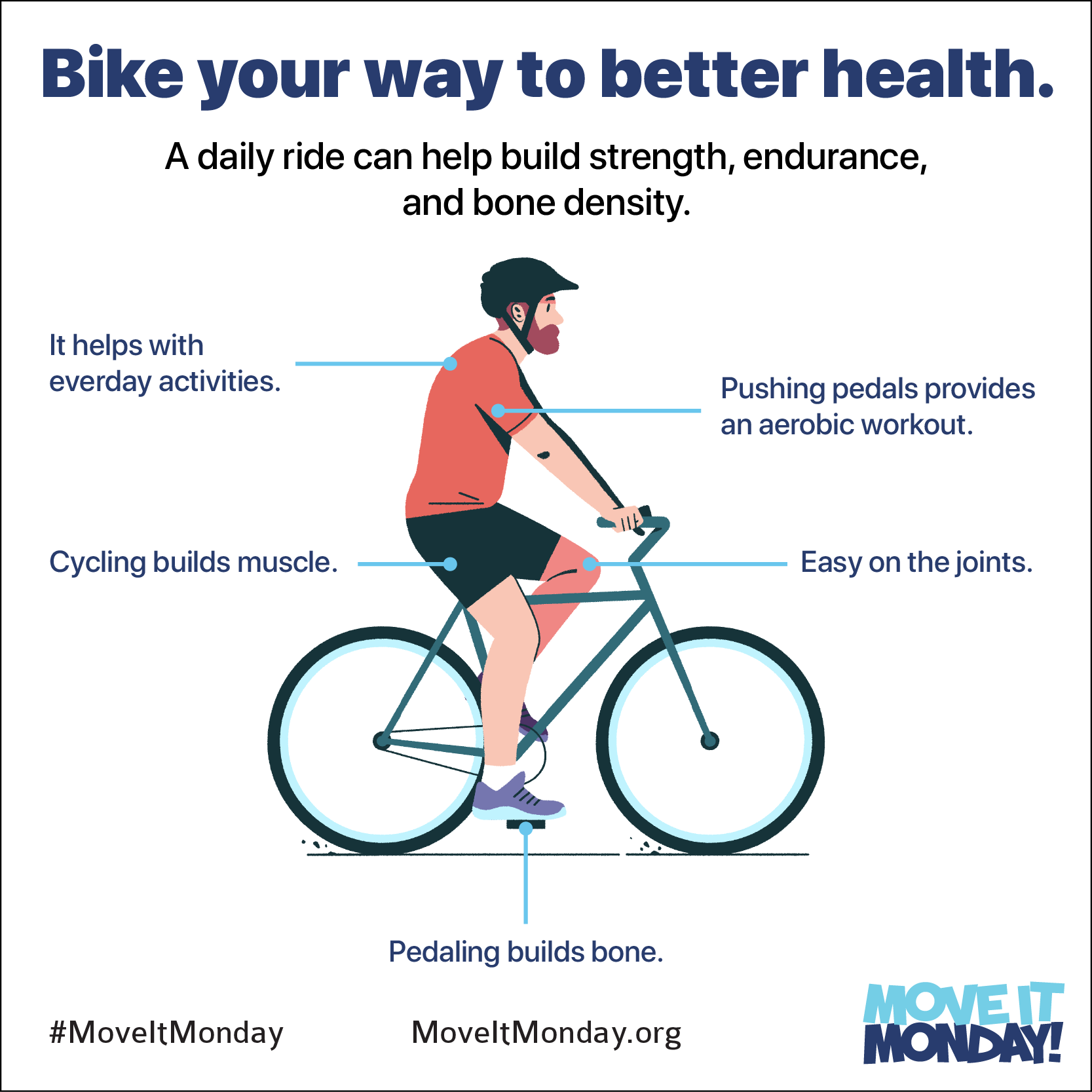Thank goodness we never forget how to ride a bike, because besides being a convenient and environmentally-friendly mode of transportation, cycling is an excellent source of physical activity for a wide-range of fitness levels.
Cycling has a number of advantages that other forms of exercise don’t.
First, it’s low impact, which means less strain on the bones and joints compared to other aerobic workouts like running or jogging. Second, biking hits all of the major muscle groups from the waist down, strengthening your quadriceps, hamstrings, glutes, and lower back, which are all important to improving balance, endurance, and the ability to stand and walk upstairs. It also comes with a myriad of other health benefits including increased cardiovascular fitness, muscle strength, and joint mobility, as well as decreased stress levels and body. And while other sports require a group or excess equipment, all you need for cycling is a bike, a helmet, and the open road.
You don’t need to be a competitive cyclist to reap the physical rewards of biking; just go at your own pace — leisurely or intense — depending on your fitness goals. Cycling is an excellent workout, but it’s also a fun hobby for adventure seekers, granting you access to landscapes and views that you might’ve missed speeding by in the driver seat of an automobile.
So, what are you waiting for? This Monday get those bike tires pumped with air and hit the road or sidewalk or trail!
Biking for the Environment
Biking comes with benefits. Besides being a convenient mode of transportation, cycling is great for your physical health; it can help strengthen your legs and glutes, burn calories, and improve your cardiovascular health all while giving you access to the outdoors. But biking instead of using a car can also be a useful step in reducing your carbon footprint and preserving the environment.
Transportation accounts for more than half of the carbon monoxide and nitrogen oxides emitted into the air, with the average U.S. car emitting a pound of carbon dioxide per mile from burning fuel. By opting to bike, you are saving fossil fuel and reducing the number of cars on the road. Fewer cars relieves congestion and traffic and of a need for new parking lots and roadways, and more potential locations for public green spaces. Bicycles can utilize existing infrastructure, without demanding too much in terms of road construction and parking spaces. They’re also quiet, which means no honking or obnoxious noise pollution.
But most importantly, biking around our neighborhoods gives us a greater appreciation for the surrounding natural beauty. By choosing to bike this Monday, you are embracing the outdoors, cementing an appreciation for the environment, all the while bettering your own health.
Basic Cycling Guidelines to Ensure You Stay Safe
Zipping through city streets or country roads on your bike can be an exhilarating workout, but any cyclist, no matter their skill level and comfort, should adhere to some basic biking safety protocols.
The most important safety requirement is wearing a helmet that fits your head properly. Helmet sizes differ based on manufacturer, so the only real way to know how it fits is to put it on and adjust the straps. You also want to make sure the bike you’re riding is the right size with functioning. Before your ride, make sure your shoe laces are tucked securely into your pant legs so that they don’t get tangled in the bike chain. It also helps to plan your route ahead of time. If driving on the road, choose areas with less traffic and slower speed limits; for leisurely rides, try to stick to a bike path.
You also want to do your best to avoid crashes; because, regardless of who is responsible, if a cyclist falls or collides with another vehicle, they are often the one who suffers with the physical consequences. According to the National Highway Traffic Safety Administration, most bicyclist deaths occur between 6:00 pm and 9:00 pm in urban areas, so try to avoid riding during these times of day when visibility is limited. If you do decide to ride during dusk or the evening, use reflective gear and clothing as well as a flashing front and rear light.
Bicycles on the roadway have the same rights and responsibilities as motorized vehicles. Riding defensively is the best way to avoid an accident. Drive with the flow of traffic, obey street signs, signals, and road markings, and always assume that the other person or vehicle doesn’t see you. When biking, riders should be as predictable as possible, using hand signals and following the other rules of the road.
Follow these basic guidelines to ensure your Monday ride is a safe success.


